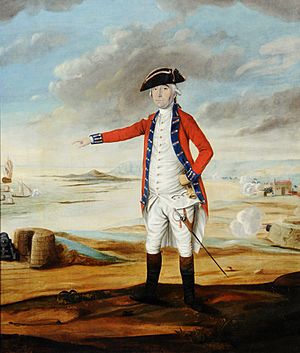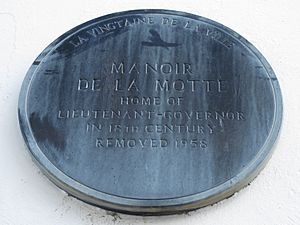Moses Corbet facts for kids
Quick facts for kids
Moses Corbet
|
|
|---|---|

Major Moses Corbet
|
|
| Born | 1728 |
| Died | 1814 (aged 85–86) |
| Allegiance | |
| Service/ |
|
| Rank | Major |
| Commands held | Garrison of Jersey |
| Battles/wars | American Revolutionary War Battle of Jersey |
Moses Corbet (born 1728, died 1814) was an officer in the British Army. He was the Lieutenant Governor of Jersey from 1771 to 1781. This meant he was in charge of the island's defense and government. He played an important role in protecting Jersey during the American Revolutionary War.
Contents
Early Life and Military Career
Corbet joined the British Army around 1745. By 1748, he was an Ensign, which is a junior officer rank. He later became a Captain. This happened just before the Seven Years' War began.
Serving in the Seven Years' War
During the Seven Years' War, Corbet sailed with his regiment to help at the Siege of Fort St Philip (1756) in Menorca. A siege is when an army surrounds a place to try and capture it. This attempt to help failed. His regiment then moved to Gibraltar, where he served for a while. He had to return to England because he became unwell.
While in England, Corbet got married. He also became an Aide-de-camp to Lieutenant Colonel Lord Robert Bertie. An Aide-de-camp is an assistant to a senior officer. Corbet later rejoined his regiment in Gibraltar. On December 14, 1761, he was promoted to Major.
Becoming Lieutenant Governor of Jersey
After returning to England with his regiment, Corbet left the army due to his health. He settled back in Jersey in the Channel Islands. He became involved in local politics. After some disturbances in 1769, he was appointed Lieutenant Governor of Jersey on April 4, 1771.
In 1779, French and Dutch forces tried to invade Jersey at St Ouen's Bay. Moses Corbet led the island's defenders. They successfully stopped the landing. Only a few of their men were hurt when a cannon accidentally burst.
The Battle of Jersey
On January 6, 1781, a French invasion force attacked Jersey. It was led by a general named Philippe de Rullecourt. They managed to take control of the town of Saint Helier. They surprised Corbet while he was in bed at Government House.
A Surprise Attack
De Rullecourt convinced Corbet that thousands of French troops had already taken over Jersey. He threatened to burn the town and harm its people if the British soldiers did not give up. Corbet could not find out the real situation. Believing the threats, he surrendered.
The British Fight Back
However, Major Francis Peirson suspected that De Rullecourt only had a small force. Peirson took command of the British troops because Corbet was a prisoner. He led a counter-attack. This led to a major battle where the British forces won.
What Happened Next?
After the battle, Corbet was put on trial by a Court-martial at Horseguards. A court-martial is a military court. He was accused of:
- Being surprised by the enemy.
- Signing surrender papers while he was a prisoner.
- Trying to get other officers to agree to surrender.
The French General had written the surrender letter himself. He threatened to destroy the town and ships in the harbor if Corbet did not sign. He also shared many details about the island's defenses. This made Corbet believe that many British units had already been captured. Corbet signed the papers to save the town from being burned. He also believed he no longer had command because he was a prisoner.
Corbet received good references from people like Lord Robert Bertie. The court-martial did not have a clear conclusion. He was removed from his position as Lieutenant-Governor. However, he was given a pension of £250 per year for the rest of his life.
His Portrait
A full-length portrait of Major Moses Corbet was painted by the famous artist Philippe Jean (1755–1802). Philippe Jean was well-known for his small portraits. He also painted a portrait of King George III.


